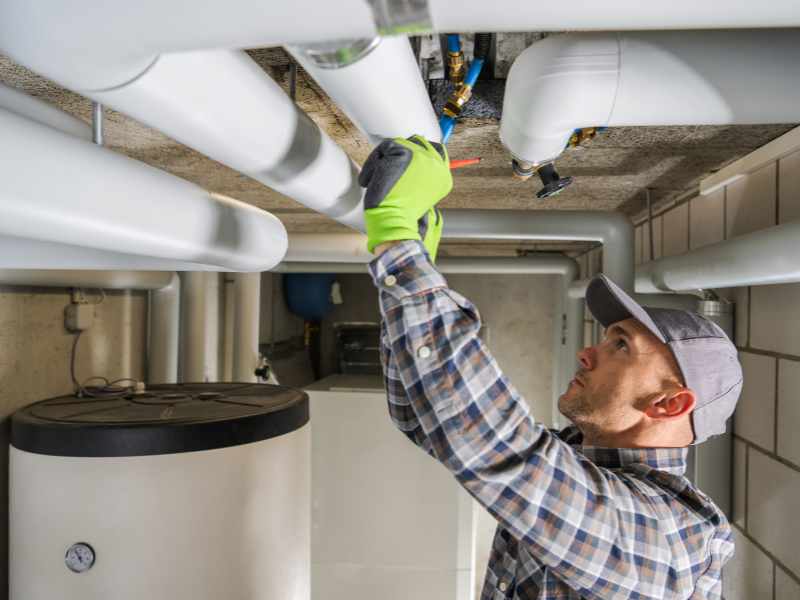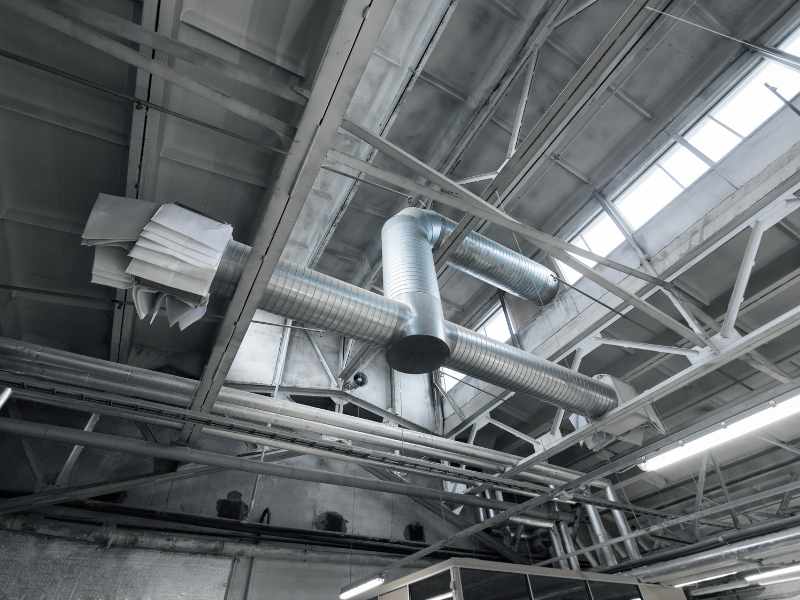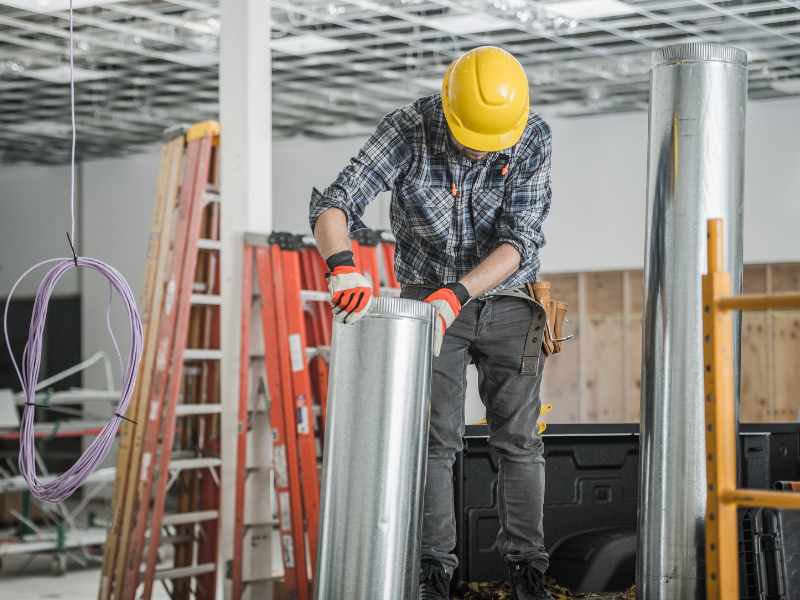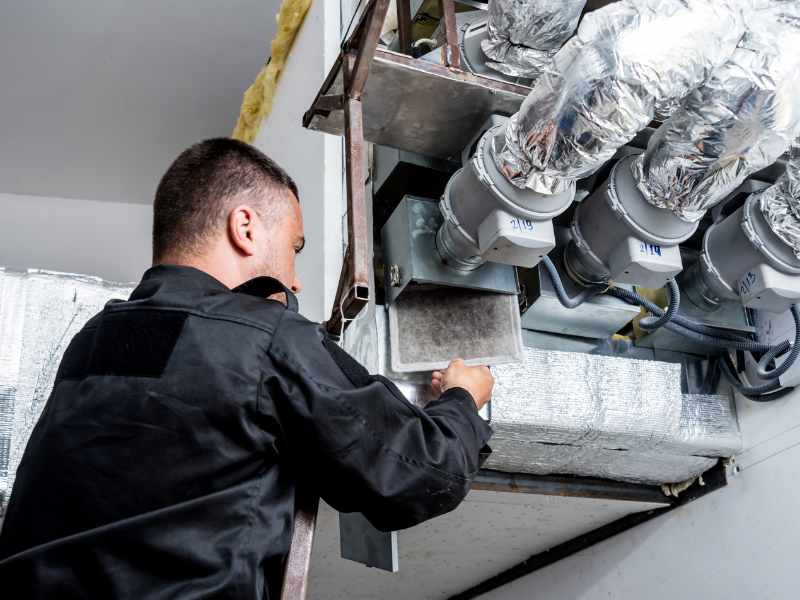Cost To Install HVAC System With Ductwork

HVAC systems, often overshadowed by flashier home improvements, hold a pivotal role in ensuring home comfort and efficiency. They bring a unique blend of functionality and energy savings that can’t be matched by other upgrades. This distinct advantage sets HVAC systems apart in the realm of home enhancements, marking them as a critical investment for homeowners.
Key types of HVAC systems include Central Air Conditioners, Heat Pumps, and Furnaces, each known for their specific benefits. Single and Multi-Zone systems also offer tailored solutions, catering to diverse needs and preferences. Digging deeper, each HVAC system type showcases unique features, installation processes, energy efficiency levels, and suitability for different climates.
The following sections will delve into these aspects in detail, providing a comprehensive understanding of what makes HVAC systems an essential feature for comfortable and sustainable living.
What is HVAC?
HVAC stands for Heating, Ventilation, and Air Conditioning. It’s a comprehensive system designed to maintain indoor comfort by controlling the temperature and air quality within a space. The heating component warms up your home during the colder months, ensuring you stay cozy.
Air conditioning, on the other hand, provides relief from the heat by cooling down your living environment during warmer periods. Ventilation plays a crucial role by circulating air, removing stale air, and introducing fresh, clean air from outside. Together, these elements work in harmony to create a comfortable, healthy, and enjoyable indoor atmosphere, making HVAC systems indispensable for homes, offices, and various types of buildings.
Why Install a New HVAC System?

Installing a new HVAC system offers significant benefits that go beyond just heating and cooling your space. Firstly, it can lead to substantial energy efficiency improvements. Modern systems are engineered to consume less power, translating to lower utility bills for homeowners.
Secondly, these systems play a critical role in enhancing indoor air quality. They are adept at filtering out pollutants and allergens, ensuring the air you breathe is clean and healthy. Lastly, an updated HVAC system can boost your property’s value.
Homes equipped with efficient, contemporary systems are more appealing to buyers, potentially increasing your home’s marketability and value. In essence, upgrading to a new HVAC system is a wise investment for comfort, health, and financial well-being.
Energy Efficiency
Modern HVAC systems boast higher SEER (Seasonal Energy Efficiency Ratio) and AFUE (Annual Fuel Utilization Efficiency) ratings, making them far more energy-efficient than older units. This translates to significant energy savings and reduced utility bills, offering both environmental and economic benefits.
Improved Indoor Air Quality
Thanks to advanced filtration technologies, contemporary HVAC systems excel at purifying indoor air. They effectively eliminate pollutants, allergens, and dust, ensuring the air you breathe is clean and healthy. The improvement in indoor air quality is particularly advantageous for individuals with allergies or respiratory conditions.
Increased Property Value
An updated HVAC system can substantially elevate your home’s market value. Properties equipped with efficient, modern heating and cooling systems are more attractive to potential buyers, often commanding higher prices. This upgrade not only enhances living comfort but also serves as a lucrative investment should you choose to sell your home.
Factors Affecting HVAC Installation Cost

The cost of installing an HVAC system with ductwork is influenced by a variety of critical factors. The type of HVAC system selected is a primary consideration, with choices such as central air conditioners, heat pumps, and furnaces each carrying distinct price points. The size of the system is another crucial factor, which is determined by the home’s square footage and ceiling height, directly impacting the cost.
The complexity of ductwork installation significantly affects the price, especially in scenarios requiring extensive modification or the installation of new ductwork. Additionally, the condition of existing ductwork and the material chosen for new installations can also sway the overall expense. Understanding these variables is essential for accurately budgeting your HVAC installation project.
Type of HVAC System
Selecting the right HVAC system—be it a central air conditioner, heat pump, or furnace—is crucial, as each type has unique installation requirements and cost implications.
Central Air Conditioners
Central air conditioners are sought after for their efficiency in cooling large areas. The installation cost is influenced by the unit’s size and its SEER rating, which measures energy efficiency.
Heat Pumps
Heat pumps serve dual purposes, providing heating and cooling solutions. While their upfront cost may be higher, they offer potential long-term energy savings.
Furnaces
Furnaces ensure a warm environment and can operate on gas, electricity, or oil. The fuel type chosen affects both the initial installation and ongoing operational costs.
Size of the System
The required size of the system is directly tied to the square footage of the home and the ceiling height, with larger spaces necessitating more powerful units to ensure efficient heating and cooling.
Square Footage of the Home
The total square footage dictates the capacity of the HVAC system needed, directly influencing the overall installation cost.
Ceiling Height
Higher ceilings mean more air volume to heat or cool, which may require a more capable HVAC system, impacting the cost.
Complexity of Ductwork Installation
The complexity of ductwork installation varies greatly, with intricate layouts and accessibility issues potentially increasing labor and material expenses.
Existing Ductwork Condition
The condition of existing ductwork can significantly affect the project’s scope. Damaged or outdated ducts might need repair or replacement, adding to the cost.
Ductwork Material
The material chosen for ductwork, from sheet metal to flexible ducting, also plays a role in the cost. Each material offers different advantages and comes with its own price tag.
Average Cost of HVAC Installation

The average cost to install an HVAC system with ductwork can vary widely, typically ranging from a few thousand dollars for simpler installations to over ten thousand for more sophisticated systems and complex ductwork scenarios. Factors such as the type of HVAC system, the size of the home, and the complexity of the ductwork installation significantly influence the final cost. Additionally, regional variations affect the overall expenses, with differences in local labor rates and material costs playing a crucial role.
By understanding these average cost ranges, homeowners can better budget for their HVAC installation, ensuring they make choices that align with their needs and financial constraints.
National Averages
On a national scale, the cost to install an HVAC system with ductwork generally ranges from $5,000 to $10,000. However, for more advanced systems or installations involving significant ductwork modifications, this price can exceed the upper end of the average range. These figures provide a baseline, aiding homeowners in setting a preliminary budget.
Cost Variations by Region
Installation costs for HVAC systems exhibit notable variations by region, influenced by local factors such as labor rates and material costs. In high-cost living areas, installation expenses can surpass the national average, whereas regions with lower living costs may offer more economical pricing. Recognizing these discrepancies is crucial for homeowners to budget effectively, taking into account the specific economic conditions of their locality.
Cost Breakdown of HVAC Installation

A detailed understanding of the cost breakdown for HVAC installation helps homeowners navigate their upgrade process more effectively. Essentially, the total expense is segmented into the cost of the HVAC unit and the cost of ductwork installation. The unit’s price is influenced by its type, size, and efficiency, with high-efficiency models typically commanding a premium.
On the other hand, the expenses for ductwork installation encompass both material and labor costs, which can vary significantly based on the project’s complexity and the chosen ductwork materials. Grasping these components allows homeowners to better plan and budget for their HVAC installation, ensuring a smooth and successful update to their heating and cooling system.
Cost of the HVAC Unit
The cost of the HVAC unit is influenced by factors such as the system’s type, size, and efficiency level. Basic models may start from a few thousand dollars, while high-efficiency or technologically advanced units can exceed ten thousand dollars.
Price Ranges by Type
The price of an HVAC system varies by type. Central air conditioners and heat pumps typically have higher initial costs compared to furnaces. Each system offers unique benefits, including differences in energy efficiency and heating/cooling capabilities.
Cost of Ductwork Installation
Ductwork installation constitutes a significant portion of the project’s total cost, encompassing material and labor expenses. The complexity of the installation, the state of any existing ductwork, and the materials selected can all influence the final price.
Material Costs
Material costs for ductwork installation can vary, depending on the choice between sheet metal, fiberglass, or flexible ducting. Each material comes with distinct advantages and associated costs, impacting the overall investment.
Labor Costs
Labor costs are affected by the installation’s complexity, the technician’s expertise, and prevailing regional labor rates. More intricate projects or those requiring modifications to existing systems tend to be more labor-intensive, thus increasing the cost.
How to Save Money on HVAC Installation

Saving money on an HVAC installation doesn’t mean cutting corners; it’s about making smart, informed choices. Opting for the right-sized HVAC system for your space can prevent overspending on unnecessary capacity. Focusing on the system’s SEER rating is key, as units with higher ratings are more energy-efficient, leading to reduced utility costs in the long run.
Investing in energy-efficient HVAC models might come with a higher upfront cost but can result in significant savings over time. Additionally, homeowners should explore available tax credits, rebates, and incentives from federal and state programs, which can substantially lower initial expenses. By considering these strategies, you can achieve a balance between upfront costs and long-term savings, ensuring your HVAC installation is both cost-effective and efficient.
Choosing the Right HVAC System
Identifying the correct HVAC system for your needs involves evaluating your home’s square footage and local climate conditions. Opting for a system that matches your space ensures efficiency and cost-effectiveness, avoiding the pitfalls of under or oversizing.
SEER Rating Importance
The SEER (Seasonal Energy Efficiency Ratio) rating is a crucial metric for assessing an air conditioner’s efficiency. Systems with higher SEER ratings are more energy-efficient, translating to significant savings on utility bills.
Considering Energy-Efficient Options
Investing in energy-efficient HVAC options may come with a higher initial price tag but can lead to substantial long-term savings. These systems consume less energy, reducing your carbon footprint and monthly energy expenses.
Tax Credits and Rebates
Exploring tax credits and rebates for energy-efficient HVAC installations can significantly lower upfront costs. These financial incentives are designed to encourage homeowners to invest in greener, more efficient systems.
Seeking Rebates and Incentives
Actively searching for rebates and incentives from utility companies, manufacturers, and government entities can further reduce the cost of installing an energy-efficient HVAC system, making it an even more attractive investment.
Federal and State Programs
Federal and state programs often provide incentives to promote the adoption of energy-efficient HVAC solutions. These programs can offer substantial financial benefits, helping to offset the initial investment while supporting environmental sustainability.
Finding a Reputable HVAC Installer

Securing a reputable HVAC installer is a pivotal step towards a successful system installation. Ensure the installer holds the necessary licensing and certification, indicators of their adherence to industry standards and proficiency. Delving into customer reviews and ratings offers a glimpse into their track record, shedding light on their reliability and the quality of their workmanship.
A credible installer not only guarantees an efficient HVAC installation process but also provides expert guidance on selecting the optimal system for your specific needs, which can lead to significant savings and enhanced system durability. Prioritizing these aspects will guide you to an HVAC professional committed to excellence and customer satisfaction.
Licensing and Certification
It’s essential to verify that your HVAC installer possesses the necessary licensing and certification. These qualifications serve as proof that the professional has met rigorous training standards and is knowledgeable about the latest industry practices. Hiring a licensed and certified installer ensures a higher level of workmanship and compliance with safety codes.
Customer Reviews and Ratings
Investigating customer reviews and ratings provides crucial insights into an installer’s dependability and the quality of their work. Positive testimonials from satisfied customers are a testament to the installer’s ability to deliver excellent service. This feedback is invaluable for making an informed choice when selecting your HVAC installation professional.
Preparing for HVAC Installation

Effective preparation is key to a smooth HVAC installation process and the long-term success of your system. Begin by assessing your current system’s age and efficiency to gauge the need for an upgrade. Proper planning entails understanding your home’s layout and pinpointing optimal spots for units and ductwork to ensure maximum efficiency.
Preparing your home for the installation, such as decluttering the work area and providing clear access, can greatly expedite the process and minimize potential issues. Taking these proactive steps not only facilitates a more efficient installation but also contributes to the overall performance and longevity of your HVAC system.
Evaluating Your Current System
Begin by thoroughly assessing your current HVAC system, focusing on its age and efficiency. Systems that are over a decade old or consistently fail to maintain desired temperatures might be due for an upgrade, marking a significant first step towards enhancing home comfort and energy efficiency.
Age and Efficiency
The age and efficiency of your HVAC equipment play pivotal roles in determining the need for a new installation. Older units, typically those more than 10 years old, or systems that exhibit poor efficiency can lead to escalated energy bills and compromised indoor comfort.
Planning for the Installation Process
Strategic planning for the installation is essential. It encompasses evaluating the best locations for new units and any necessary modifications to existing ductwork. Such planning ensures the installation proceeds smoothly, without unexpected issues.
Home Preparation Tips
Preparing your home for the installation can significantly impact the process’s efficiency. Clearing the vicinity of the furnace and external units, providing clear access paths for technicians, and safeguarding valuables and pets are all crucial steps. These preparations help in minimizing disruptions and facilitating a seamless installation experience.
Maintenance Tips For Your New HVAC System

Proper maintenance is key to maximizing the longevity and efficiency of your new HVAC system. One of the simplest yet most impactful actions is regularly changing the filters. Changing filters prevents dust and debris from compromising the system’s performance.
Additionally, scheduling professional maintenance at least once a year allows experts to identify and resolve any issues early, averting expensive repairs. Ensuring the outdoor units are clear of debris and indoor vents are unobstructed also plays a crucial role in maintaining optimal efficiency. By following these maintenance tips, you can enjoy sustained comfort in your home and achieve significant energy savings throughout the lifespan of your HVAC system.
Regular Filter Changes
Implementing regular filter changes is a vital maintenance task for your HVAC system. Keeping filters clean not only ensures efficient airflow and operation but also prevents dust, allergens, and other airborne particles from circulating in your home. This routine care is key to prolonging your system’s lifespan and enhancing the quality of your indoor air.
Scheduled Professional Maintenance
Committing to scheduled professional maintenance at least once a year is crucial for the health of your HVAC system. Certified technicians can conduct thorough inspections and tune-ups, spotting and addressing any minor issues before they escalate into costly repairs. Heating and AC maintenance is a preventative measure that ensures your system operates at peak efficiency, ultimately saving you money and extending the unit’s operational life.
ALSO READ: How to Clean HVAC Ducts and Improve Air Quality
In Summary
Investing in an HVAC system with ductwork is a strategic move towards enhancing home comfort, energy efficiency, and property value. Understanding the various types of systems, the factors affecting installation costs, and the importance of energy efficiency and regular maintenance will guide you in making informed decisions. By selecting the right system, exploring available financial incentives, and choosing a reputable installer, you can ensure a successful and cost-effective HVAC installation.
Ready to upgrade your home’s comfort and efficiency with a new HVAC system? Contact Callidus Air today for expert HVAC installation and maintenance services tailored to your needs. Experience unparalleled comfort and peace of mind with our top-notch HVAC solutions.
